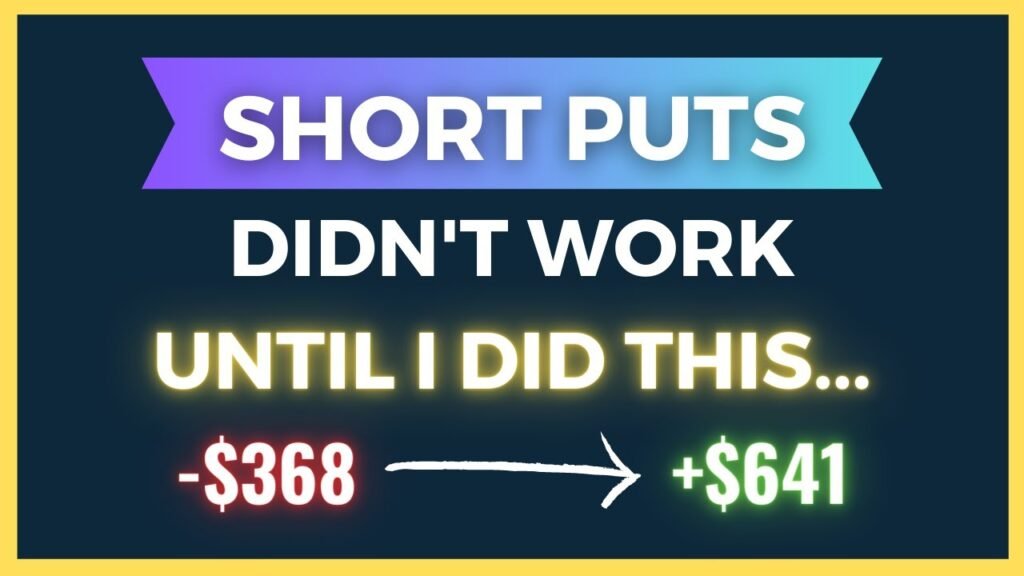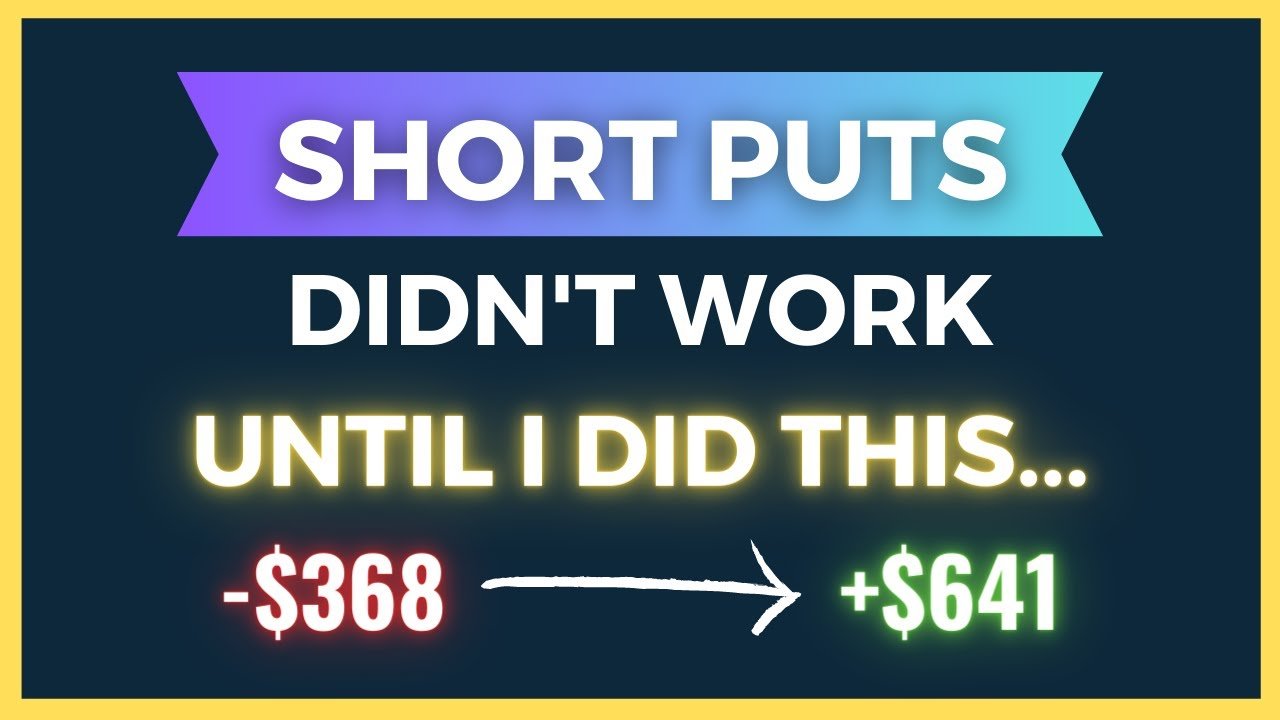Are you a beginner looking to learn how to manage losing short puts? Well, you’re in luck because “The Ultimate Beginner’s Guide To Managing Losing Short Puts” is here to help! This article outlines the key strategies and actions you can take to salvage a losing short put position, ultimately turning it into a winning one. From understanding the risk profile and break-even point to knowing when to cut losses or roll the position, this guide covers it all. Proper risk management and capital allocation are emphasized, ensuring you make informed decisions and minimize potential losses. So, if you want to navigate the world of short put trading with confidence, this friendly guide is just what you need!
Are you tired of losing on your short put positions? Look no further than “The Ultimate Beginner’s Guide To Managing Losing Short Puts” by Options with Davis. This guide is designed to help you navigate the challenges of managing a losing short put position and turning it into a profitable one. From understanding the risk profile and break-even point to taking the right actions based on market conditions and time remaining to expiration, you’ll learn all the strategies you need to succeed. With a focus on proper risk management and capital allocation, this guide ensures you can make informed decisions and protect your trading account. So, if you’re ready to take control of your short put positions, dive into this friendly and comprehensive guide today!
Understanding Short Puts
Overview of Short Puts
Short puts refer to an options strategy where traders sell put options with the expectation that the underlying stock’s price will either remain the same or increase. This strategy can lead to quick profits when the market moves in the right direction.
Potential Profits and Risks
When executing a short put strategy, there is a potential for higher profits compared to buying a put option. The trader receives the premium from selling the put option and keeps it if the options expire out of the money. However, there are risks involved, as the market can go against you and result in a losing short put position.
Importance of Risk Management
Effective risk management is crucial when trading short puts. It helps protect your capital and minimize potential losses. By implementing proper risk management practices, you can ensure that your trading strategies are aligned with your risk tolerance and financial goals.
Managing a Losing Short Put Position
Importance of Break-Even Point
To effectively manage a losing short put position, it is essential to understand the concept of the break-even point. The break-even point is the point at which the position neither makes a profit nor incurs a loss. Identifying this point enables traders to determine if their position is still in the profit zone.
Cut Loss if Loss Equals Initial Buying Power Requirement
If the market goes against you and your short put position incurs a loss that equals the initial buying power requirement, it is recommended to cut the loss. By doing so, you prevent the loss from growing even larger and protect your trading account.
Giving Time if Max Loss Not Hit and >21 Days to Expiration
If the maximum loss has not been hit and there are still more than 21 days to expiration, it may be prudent to give the trade more time. Markets can be unpredictable, and waiting it out can sometimes lead to a turnaround in the position.
Options with Less Than 21 Days to Expiration
When there are less than 21 days to expiration and the max loss has not been hit, traders have three options to consider. They can choose to take a loss, roll the position out, or roll the position out and down. Each option comes with its own set of risks and potential outcomes, so careful consideration is necessary.
Reducing Risk and Volatility at 21 Days to Expiration
Managing trades at the 21 days to expiration mark can help reduce risk and volatility. At this point, traders may consider adjusting their position or making strategic decisions based on market conditions and the remaining time to expiration.
Factors for Decision Making
When managing a losing short put position, several factors come into play when making decisions. These include the trader’s risk profile, the time remaining to expiration, and current market conditions. By considering these factors, traders can make informed decisions that align with their overall trading strategy.

Strategies for Turning a Losing Position into a Winning One
Analyzing Market Conditions
Analyzing market conditions is essential when attempting to turn a losing short put position into a winning one. By understanding the current market trends and potential catalysts, traders can make more informed decisions about whether to hold, adjust, or exit their position.
Adjusting the Position
Adjusting the position involves making changes to the existing short put position. This can include rolling the position out, adding or subtracting contracts, or incorporating other options strategies to mitigate potential losses and improve the overall risk-reward profile.
Rolling the Position Out
Rolling the position out involves closing the existing short put position and simultaneously opening a new position with a later expiration date. This strategy allows traders to extend the time available for the market to turn in their favor and potentially recover from the loss.
Rolling the Position Out and Down
Rolling the position out and down involves closing the existing short put position and simultaneously opening a new position with a lower strike price. This strategy can potentially reduce the risk and exposure associated with the original position while still allowing for potential profitability.
The Importance of Risk Management
Proper Risk Management Practices
Practicing proper risk management is crucial for successful trading, particularly when dealing with short puts. This includes setting appropriate stop-loss orders, diversifying your trading portfolio, and closely monitoring market conditions. By implementing these practices, traders can minimize potential losses and protect their capital.
Capital Allocation Strategies
Proper allocation of capital is key to managing risk effectively. Traders should limit the size of their short put positions to a maximum of five to seven percent of their total trading capital. This ensures that losses from a single trade will not disproportionately impact the overall portfolio.
Understanding Statistics and Probabilities
Understanding the statistics and probabilities associated with short put trading is essential for making informed decisions. Traders should be familiar with concepts such as delta, theta, and implied volatility to evaluate the potential risks and rewards of their positions accurately.
Recommended Resources
Options with Davis Video
The Options with Davis video provides valuable guidance on managing and salvaging a losing short put position. It offers strategies and insights to help traders turn a losing position into a winning one.
Related Videos
There are other informative videos available that cover related topics and may be of interest to traders looking to expand their knowledge on short put strategies and risk management.
Additional Learning Materials
Traders can further enhance their understanding of short put strategies and risk management by exploring additional learning materials, such as books, articles, and online courses. These resources provide in-depth information and practical tips for successfully managing short put positions.
Conclusion
Managing a losing short put position requires a combination of risk management techniques, market analysis, and decision-making strategies. By understanding the concepts discussed in this article and implementing effective risk management practices, traders can navigate challenging market conditions and potentially turn a losing position into a winning one. Remember to always stay informed, make calculated decisions, and prioritize the protection of your trading capital.
